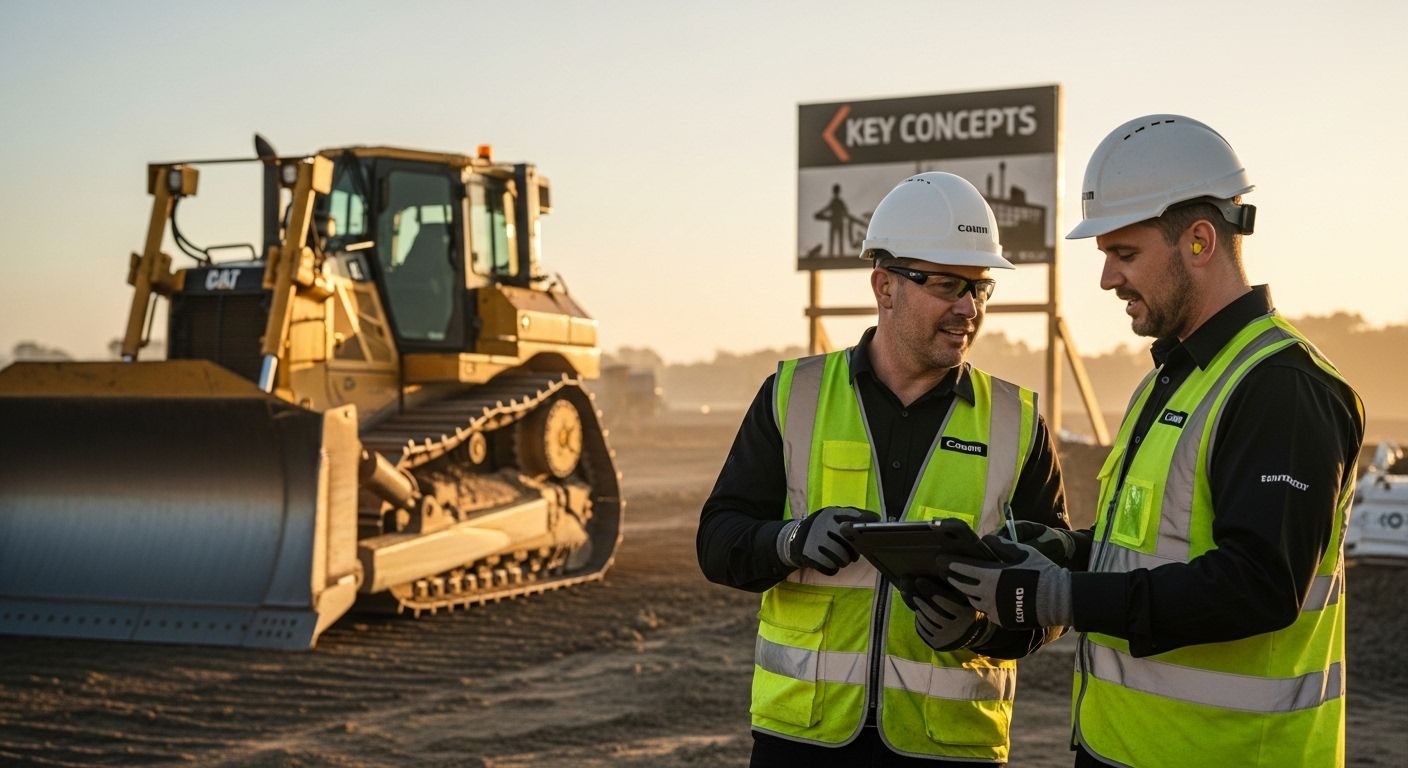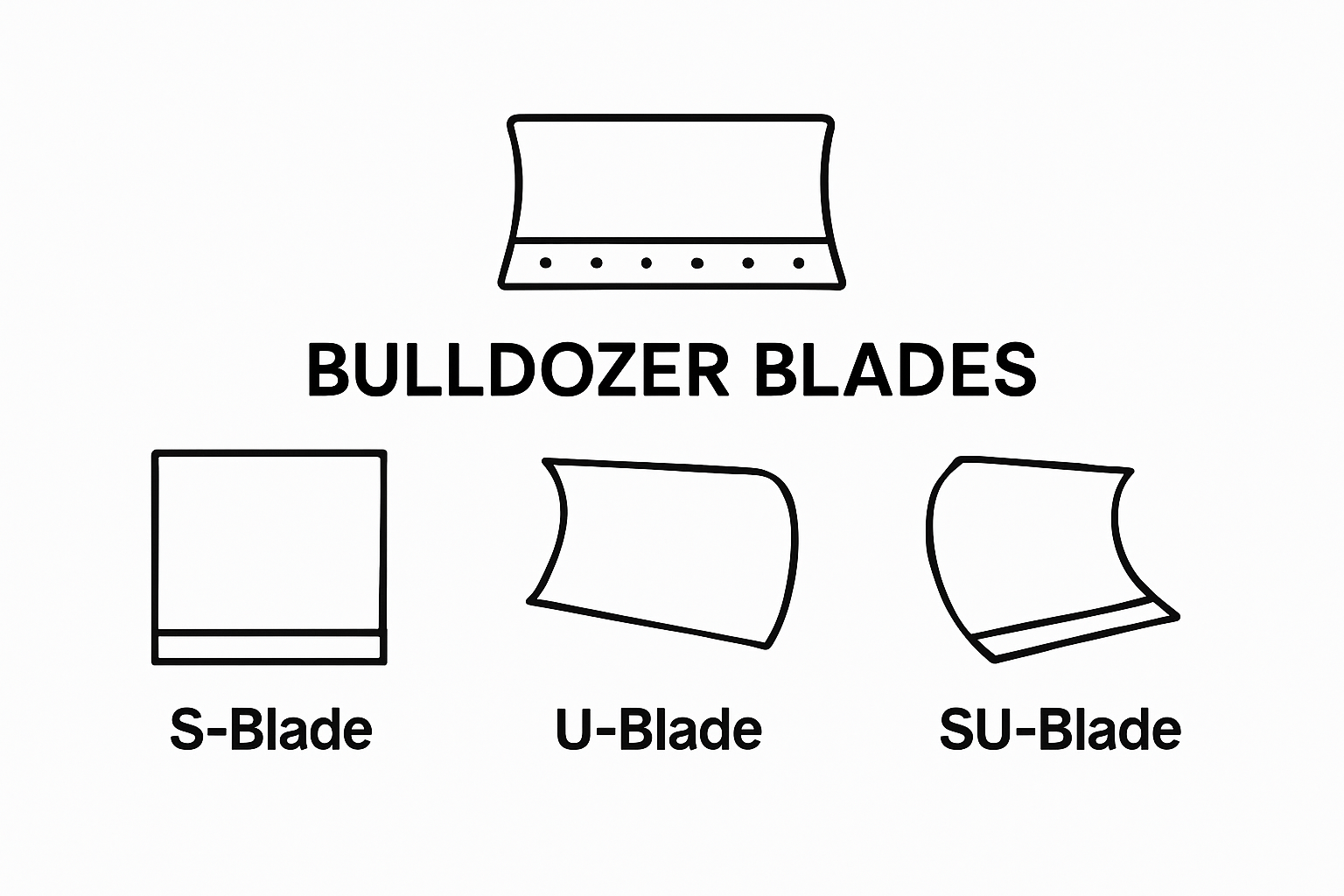
Bulldozers are more than just massive machines with steel blades—they are the powerhouses that shape city skylines, carve highways, and reclaim farmland. These unstoppable giants can move over 50 tons of earth in a single push, turning raw wilderness into sites ready for progress. Most people think a bulldozer’s strength is all about brute force, but their real value lies in how precisely they can sculpt the land with pinpoint control.
Table of Contents
- What Is A Bulldozer And Its Purpose In Construction?
- The Importance Of Bulldozers In Various Industries
- How Bulldozers Function: Mechanisms And Technology
- Key Components Of A Bulldozer And Their Roles
- Real-World Applications Of Bulldozers In Different Fields
Quick Summary
| Takeaway | Explanation |
|---|---|
| Bulldozers are key in construction. | They are essential for land preparation, site clearing, and foundation creation in various building projects. |
| Versatile across multiple industries. | Bulldozers support agriculture, environmental management, mining, and infrastructure development with their powerful earthmoving capabilities. |
| Tracked design enhances stability. | Their tracked undercarriage provides superior traction, enabling operation on soft or uneven terrains where wheeled vehicles struggle. |
| Advanced hydraulics allow precision. | Hydraulic systems enable nuanced blade adjustments for accurate material handling and efficient earthmoving tasks. |
| Modern tech elevates performance. | Features like GPS and laser-guided systems enhance operational precision, transforming bulldozers into intelligent machinery. |
What is a Bulldozer and Its Purpose in Construction?
A bulldozer represents one of the most powerful and versatile pieces of heavy machinery used in construction, earthmoving, and industrial projects. These robust machines are designed to push, pull, and manipulate large quantities of soil, rock, and debris with remarkable efficiency.
Understanding Bulldozer Mechanics
Bulldozers operate using a powerful tracked vehicle equipped with a wide, flat blade at the front called a dozer blade. This blade allows operators to move significant volumes of material across various terrains, making them essential in construction sites, mining operations, and land development projects. The tracked design provides exceptional stability and traction, enabling these machines to traverse challenging surfaces like muddy ground, rocky terrain, and uneven landscapes.
Key mechanical features of bulldozers include:
- Robust diesel engines generating substantial horsepower
- Heavy-duty metal tracks providing superior ground contact
- Adjustable blades for different earthmoving tasks
- Hydraulic systems enabling precise blade control
Construction and Industrial Applications
Bulldozers play a critical role in numerous industrial sectors. According to research from the Construction Equipment Guide, these machines are fundamental in preparing construction sites, clearing land, creating foundations, and managing large-scale earthmoving projects. Their versatility allows them to perform tasks ranging from initial land clearing to precise grading and material distribution.
Construction professionals rely on bulldozers for:
- Clearing vegetation and debris
- Creating access roads
- Leveling ground for building foundations
- Excavating and relocating massive soil volumes
- Assisting in landfill and mining operations
The adaptability of bulldozers makes them indispensable across multiple industries, from urban development and infrastructure projects to agricultural land preparation and environmental restoration efforts. Their powerful design and precision engineering continue to make them a cornerstone of modern heavy machinery operations.
The Importance of Bulldozers in Various Industries
Bulldozers are critical machinery that transform landscapes and drive progress across multiple sectors. These powerful machines are not just construction tools but versatile problem solvers that enable complex industrial operations worldwide.
Infrastructure and Urban Development
In urban development and infrastructure projects, bulldozers serve as foundational machines that prepare terrain for future construction. Large-scale infrastructure projects depend on bulldozers to clear land, create access roads, and establish stable ground for buildings, highways, and public spaces. According to research from the Federal Highway Administration, these machines are essential in creating the physical foundations that support modern society’s infrastructure needs.
Key infrastructure applications include:
- Preparing sites for residential and commercial developments
- Creating transportation corridors
- Establishing drainage systems
- Removing obstacles and vegetation
- Grading and leveling large land areas
Agricultural and Environmental Transformation
Beyond construction, bulldozers play a significant role in agricultural and environmental management. Farmers and land management professionals use these machines to transform landscapes, clear fields, create irrigation channels, and manage large tracts of land. Their ability to move substantial volumes of earth makes them invaluable in land reclamation and environmental restoration projects.
Critical agricultural and environmental uses involve:
- Clearing land for crop cultivation
- Creating agricultural terraces
- Managing forest and wildland areas
- Controlling erosion
- Supporting wildlife habitat restoration
Mining and Resource Extraction
In mining and resource extraction industries, bulldozers are essential for excavation, material movement, and site preparation. These machines navigate challenging terrains, remove overburden, create access roads, and support complex mining operations. Their robust design allows them to operate in extreme conditions, making them indispensable in extracting critical resources that fuel global economic development.
The remarkable versatility of bulldozers demonstrates their significance beyond simple earthmoving. They are dynamic machines that reshape landscapes, support industrial progress, and provide critical solutions across diverse sectors of human activity.
How Bulldozers Function: Mechanisms and Technology
Bulldozers are complex machines that combine powerful engineering with precise technological design to accomplish challenging earthmoving tasks. These remarkable vehicles transform raw mechanical power into controlled, strategic landscape manipulation.
Core Mechanical Components
At the heart of a bulldozer’s functionality are its critical mechanical systems that work in seamless coordination. The primary components include a robust diesel engine, hydraulic systems, and a tracked undercarriage that provides exceptional stability and maneuverability. According to engineering research from Massachusetts Institute of Technology, these systems enable precise material movement across diverse terrains.
Key mechanical elements include:
- High-torque diesel engines generating substantial horsepower
- Complex hydraulic control systems
- Reinforced steel tracks with specialized traction designs
- Articulated blade mechanisms for angular adjustments
- Advanced suspension systems for terrain adaptation
Operational Dynamics and Control
Bulldozer operators control these machines through sophisticated interfaces that translate human input into precise mechanical actions. Hydraulic control systems allow for nuanced blade positioning, enabling operators to manipulate materials with remarkable accuracy. The tracked design distributes machine weight evenly, reducing ground pressure and allowing movement across soft, uneven surfaces where wheeled vehicles would struggle.
Critical operational capabilities include:
- Precise blade angle and depth management
- Lateral and vertical material displacement
- Navigation through challenging terrain
- Real-time operational adjustments
- Minimal ground disturbance during movement
Advanced Technological Integration
Modern bulldozers increasingly incorporate advanced technologies like GPS tracking, laser-guided grading systems, and computer-assisted control mechanisms. These technological enhancements transform traditional bulldozers from purely mechanical machines into intelligent, data-driven tools that can execute complex earthmoving tasks with unprecedented precision.
The evolution of bulldozer technology represents a remarkable intersection of mechanical engineering, hydraulic design, and digital innovation. These machines continue to push the boundaries of what is possible in landscape transformation, infrastructure development, and industrial earth manipulation.
Key Components of a Bulldozer and Their Roles
Bulldozers are sophisticated machines composed of intricate components working together to accomplish complex earthmoving tasks. Understanding each part’s function provides insight into how these powerful machines transform landscapes and support industrial operations.
Primary Structural Components
The fundamental structure of a bulldozer consists of several critical engineering elements that enable its remarkable performance. According to research from the Construction Equipment Engineering Association, these components are meticulously designed to withstand extreme working conditions and provide maximum operational efficiency.
Key structural components include:
- Robust steel frame providing machine rigidity
- Reinforced chassis supporting total machine weight
- Operator’s cab with ergonomic control systems
- Protective undercarriage shields
- Advanced suspension mechanisms
Propulsion and Movement Systems
Tracked undercarriage represents the bulldozer’s primary mobility mechanism, distinguishing these machines from wheeled vehicles. The continuous track design distributes machine weight across a larger surface area, enabling operation on soft, unstable terrain where traditional wheels would sink. Each track comprises numerous interconnected steel links, rollers, and drive sprockets that work in synchronized motion to provide exceptional traction and maneuverability.
Critical movement system features include:
- Heavy-duty steel track links
- Specialized track rollers and idler wheels
- Hydraulic tensioning mechanisms
- Independent track control systems
- Shock absorption capabilities
Blade and Material Manipulation Mechanisms
The bulldozer’s blade represents its most distinctive and functional component. Designed for pushing, cutting, and relocating massive volumes of earth, the blade can be adjusted in multiple angles and depths to suit specific operational requirements.

Modern blades incorporate advanced hydraulic systems that allow precise positioning and material management, transforming these machines from simple pushing tools into sophisticated earthmoving instruments.
The remarkable engineering behind bulldozers demonstrates how intricate mechanical components can be integrated to create machines capable of reshaping entire landscapes with remarkable precision and efficiency.
To clarify the specific roles and explanations of critical bulldozer components, the table below summarizes each key part and its function within the machine.
| Component | Function/Role |
|---|---|
| Diesel Engine | Generates high horsepower for pushing power |
| Tracked Undercarriage | Provides traction and stability on soft or uneven terrain |
| Dozer Blade | Moves, cuts, and grades large volumes of earth and debris |
| Hydraulic System | Enables precise blade control and adjustments |
| Operator’s Cab | Houses ergonomic controls and protects the operator |
| Steel Frame/Chassis | Supports weight and provides structural rigidity |
| Suspension Mechanisms | Absorb shocks and adapt to varied terrain for smoother operation |
Real-World Applications of Bulldozers in Different Fields
Bulldozers are versatile machines that transcend traditional construction boundaries, playing critical roles across diverse industries and challenging environments. Their unique capabilities make them indispensable tools for transforming landscapes and solving complex operational challenges.
Infrastructure and Urban Development
Large-scale infrastructure projects rely heavily on bulldozers to prepare and manipulate terrain for complex developments. According to research from the International Infrastructure Management Institute, these machines are essential in creating foundational landscapes for roads, bridges, residential complexes, and municipal facilities.
Key infrastructure applications include:
- Clearing land for new transportation corridors
- Preparing sites for residential and commercial construction
- Creating drainage and water management systems
- Leveling ground for precise architectural requirements
- Removing geological obstacles and vegetation
Agricultural and Environmental Management
In agricultural sectors, bulldozers serve as transformative tools that enable land reclamation, crop preparation, and environmental restoration. Farmers and land management professionals use these machines to reshape terrain, create irrigation systems, and manage large tracts of agricultural and wilderness lands. Precision land modification allows for more efficient farming practices and ecological conservation efforts.
Critical agricultural applications involve:
- Creating terraced farming landscapes
- Clearing fields for crop cultivation
- Developing irrigation and water management infrastructure
- Controlling soil erosion
- Supporting wildlife habitat restoration projects
Mining and Resource Extraction
The mining industry depends on bulldozers for complex excavation, material movement, and site preparation tasks. These machines navigate extreme terrains, remove overburden, create access roads, and support intricate mining operations. Their robust design enables them to operate in challenging environments where conventional machinery would fail.
The remarkable versatility of bulldozers demonstrates their significance beyond simple earthmoving. They are dynamic machines that reshape landscapes, support industrial progress, and provide critical solutions across multiple sectors of human activity, transforming how we interact with and modify our physical environment.
The following table categorizes the main fields in which bulldozers are used, highlighting their primary applications within each sector.
| Industry/Field | Major Bulldozer Applications |
|---|---|
| Infrastructure/Urban Dev. | Land clearing, grading, road preparation, building site development |
| Agriculture | Land reclamation, field clearing, terrace creation, irrigation support |
| Environmental Management | Erosion control, wildlife habitat restoration, land rehabilitation |
| Mining/Resource Extraction | Removing overburden, excavation, site prep, material movement |
| Land Development | Creating access roads, landscaping, foundation preparation |
Gear Up for the Demands of the Jobsite
After learning how bulldozers are built for precision, strength, and tough working environments, you know that performance on the construction site depends on more than just advanced machinery. Like the operators behind these powerful vehicles, you need apparel that matches your grit and keeps you protected where it counts. The article explained the challenges of managing heavy loads, harsh terrain, and unpredictable conditions—these same obstacles demand workwear with extra durability, weather resistance, and comfort for long shifts outdoors.

Why settle for less when your gear can work as hard as you do? Explore high-performance workwear built for resilience and comfort at WorkwearComfort.com. Whether you’re moving the earth or laying the groundwork, our rugged apparel supports blue-collar professionals every day. Ready for better protection and all-day confidence? Visit WorkwearComfort.com now to find your new jobsite essentials.
Frequently Asked Questions
What is the primary function of a bulldozer?
Bulldozers are heavy machinery used primarily for pushing, pulling, and manipulating large volumes of soil, rock, and debris, making them essential in construction, mining, and land development projects.
How does a bulldozer differ from other heavy machinery?
Bulldozers are uniquely designed with a tracked undercarriage that provides excellent stability and traction for moving over rough terrains, while their extensive dozer blades allow for precise earthmoving and grading tasks compared to other machines like excavators or loaders.
What are the key components of a bulldozer?
A bulldozer consists of several critical components, including a robust diesel engine, a tracked undercarriage, hydraulic systems for blade control, and a dozer blade that can be adjusted for various tasks like clearing, grading, and excavation.
In what types of projects are bulldozers commonly used?
Bulldozers are commonly used in infrastructure projects, such as road construction, land clearing for buildings, agricultural land preparation, environmental restoration, and various mining operations due to their versatility and capability to manage substantial earthmoving tasks.


